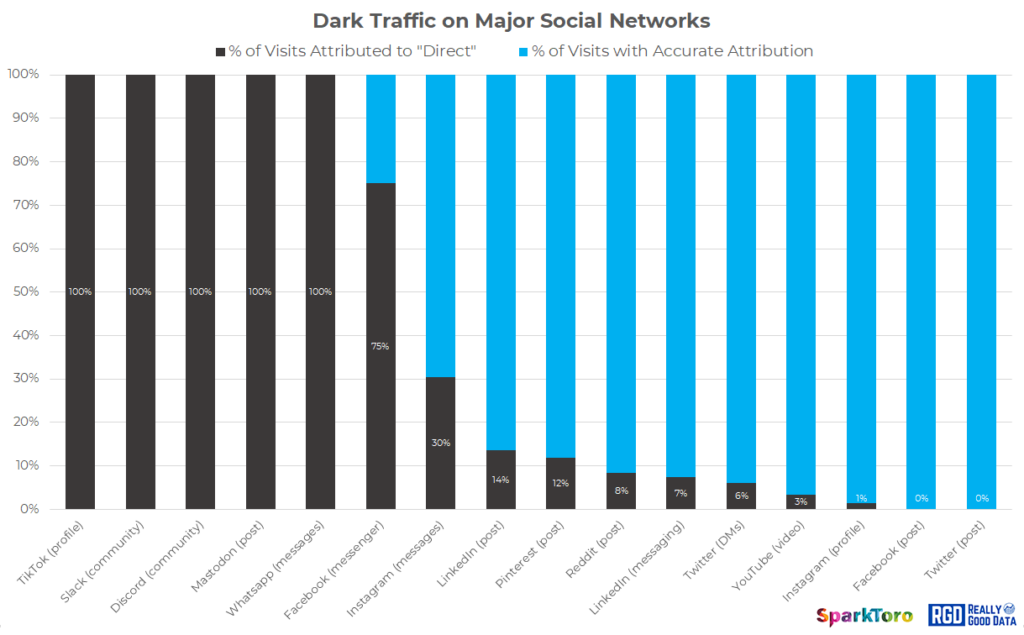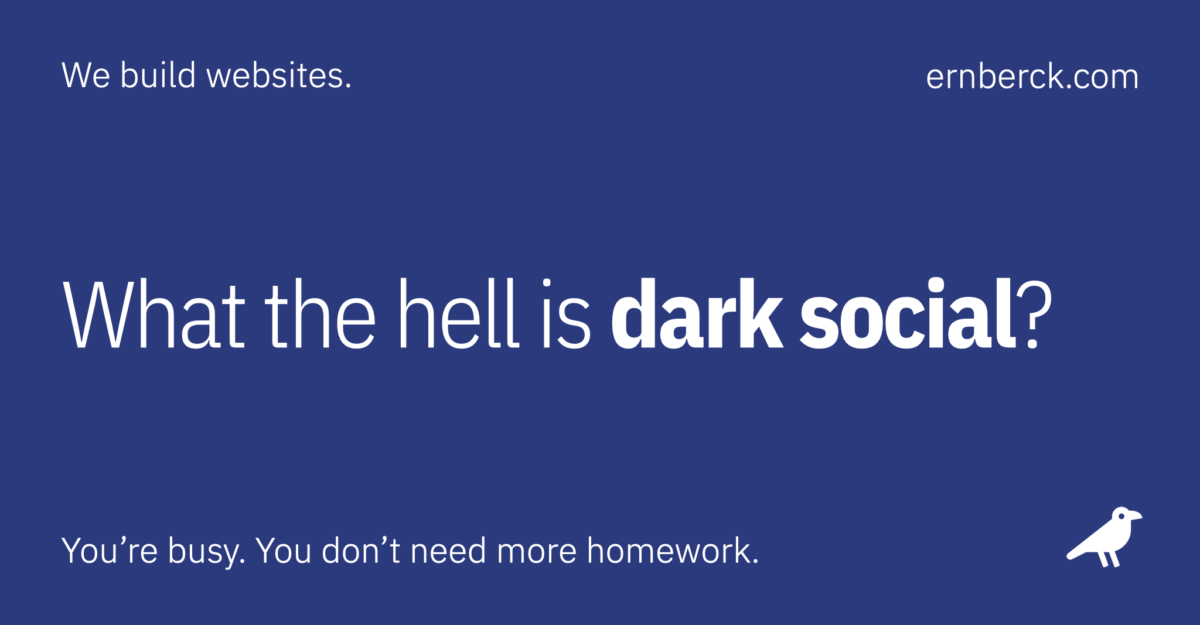The term dark social refers to content that people share through private channels — such as email, texting, and messaging apps — that can’t be easily tracked by web analytics software. More importantly, the term can also apply to referrals from mainstream social media that are incorrectly categorized as “direct” traffic.
What is dark social media?
If you’ve never heard of “dark social,” don’t feel bad. You’re not alone. In fact, a lot of marketing agencies would prefer that you not know. Their livelihood depends on the myth of conventional analytics data accuracy — along with the attribution statistics (see box below) that justify their spending patterns.
Private channels
The term dark social (aka: dark social media, dark traffic) was coined by American journalist Alexis C. Madrigal of The Atlantic magazine in 2012. It refers to content which is shared through a private channel that can’t be tracked by ordinary web analytics software.
These channels can include email, texting, podcasts, online communities, messenger apps, copy-and-paste sharing, social media, and even secure browsing. Because these sources contain no digital referral information — and therefore can’t be tracked — they are often invisible or mistakenly attributed to an incorrect channel instead. If a person uses secure browsing, then those visits also fall under the umbrella of dark social.
Some dark social referrals even show up under the generic label of direct, typed, bookmarked, or other similar names in today’s web analytics software (like Google Analytics). But make no mistake, dark social is real. By some estimates, it’s more powerful and prevalent than any one social media platform.
It’s not the Dark Web
To be clear, there’s nothing sinister or illegal about dark social. It’s not to be confused with the “Dark Web” where God-knows-what goes on. Despite the unfortunate name, dark social media is not about the content, but the traffic and method of online sharing.
Why does dark social matter?
It matters because marketers can’t measure the success of their campaigns if they don’t know which channels performed the best. Dark social sharing skews the statistics so you end up getting a distorted view of marketing performance.
Dark social traffic often inflates the “direct traffic” metric because the actual sources can’t be tracked. So, you have no idea where you’re actually getting the most traffic from.
“One dirty secret of web analytics is that the information we get is limited. There are circumstances when you show up at our doorstep and we have no idea how you got here.”
— Alexis Madrigal
The rise of dark social traffic
Dark social traffic is increasing and now comprises a majority of all social media traffic. In fact, according to a 2016 study by RadiumOne, dark social constitutes 84% of all social sharing activity.
Another analysis conducted in 2022 by Chris Walker of Refine Labs, revealed the following:
Attribution software reports 92% of our revenue is sourced via organic search or direct traffic. Meanwhile, when we ask the customer how they heard about us, 100% of revenue and 97% of our qualified pipeline gets attributed to dark social (social media, podcast, word of mouth, community).
And, an even more recent experiment done in April 2023 by SparkToro and Really Good Data concluded the following:
In summary, website owners and marketers should expect that a large portion of traffic marked as “direct” in their analytics was likely sent by these [major social media] networks. Dark Social is a real, ongoing phenomenon with problematic consequences for those who take their analytics’ channel/source reporting at face value.
Read more: Dark Social Falsely Attributes Significant Percentages of Web Traffic as Direct
These studies would suggest that companies over-invest in search engine marketing (SEM), and significantly under-invest in dark social because of this attribution bias. And they miss out on massive opportunities.
Dark social could be the largest traffic source for most websites, but most companies aren’t even measuring it. Does this mean that all of your analytics data is useless, or that you should just give up because you can’t track dark social media sharing? Probably not.

What is attribution?
In marketing, “attribution” is the identification of a set of customer actions (events or touchpoints) that contribute to a desired outcome. The purpose of attribution is to quantify the influence each advertising impression has on a customer’s decision to make a purchase (marketers like to call this “conversion”).
By default, Google Analytics (website user analytics software) uses the last-click attribution model. All credit is assigned to the last channel a user engaged with (the last click), and any previous interactions are ignored.
In theory, last-click attribution seems like the best way to measure the performance of your marketing channels, but it doesn’t tell you the full story. If you only pay attention to last-click attribution, you are effectively ignoring the performance of your entire marketing activity.
In other words, Google is telling you what captured the demand, not necessarily what created the demand. And these are two vastly different things (and too deep a concept to discuss here).
Tracking the untrackable
It’s not completely impossible to track dark social sharing. Here are a few ways to measure this data, and even several tools available that can do it for you. As you’ll see, some are more effective than others.
Google Analytics
Unfortunately, all of the instructions I found on tracking dark social with Google Analytics was old, convoluted, and applied to versions prior to Google Analytics 4 (GA4). I’m not going to confuse things by adding outdated options here.
UTM parameters
Since a user’s interactions with a link may not end after the first click, adding UTM (Urchin Tracking Module) parameters to the end of URLs is a flawed solution for tracking dark social.
For example, a URL containing an email attribution could easily be copied and pasted into a private message, or on a social media post. And the moment someone decides to paste your copied link into a different channel, your data becomes less accurate.
URL shorteners
Some social media management platforms, such as Hootsuite and Sprout Social, let you create shortened URLs for outbound links in your content. This can allow you to get a deeper analysis of the engagement rates. Shorter links also look cleaner on platforms like Twitter.
Some link shorteners allow you to track real-time clicks, and some systems have the ability to post directly to social networks like Facebook, LinkedIn, and Twitter. You can also place trackable shortened URLs in emails or on your website.
Dark social tracking tools
There are several tools that can help you track dark social content sharing or manage your social sharing in a way to avoid dark social. Two of the more popular ones are:
Summary
Dark social media could be your largest traffic source — so it’s too big to be ignored. Unfortunately, dark social sharing can prevent companies from measuring the actual effectiveness of their marketing campaigns. Since traffic is actually being driven from sources that your analytics software is not able to track, much of this engagement gets incorrectly attributed to direct traffic.
Related
Sources
Revised: October 9, 2024 at 8:23:34 AM PDT
